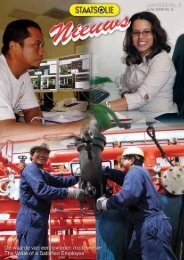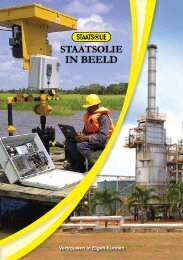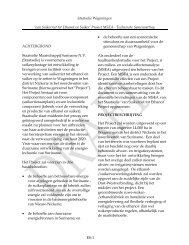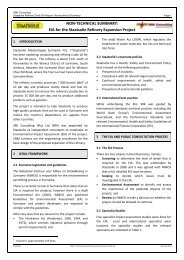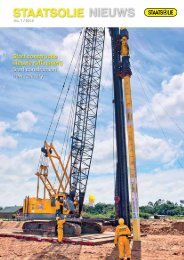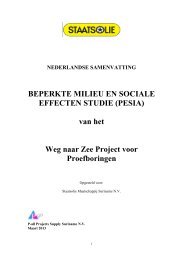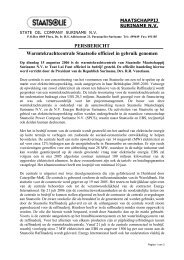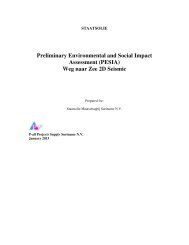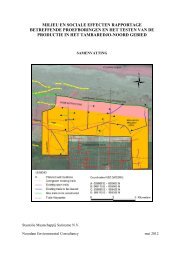concept EIA-rapport - Staatsolie
concept EIA-rapport - Staatsolie
concept EIA-rapport - Staatsolie
Create successful ePaper yourself
Turn your PDF publications into a flip-book with our unique Google optimized e-Paper software.
SRK Consulting: Project No: 439414 <strong>Staatsolie</strong> Pipeline <strong>EIA</strong> – Draft <strong>EIA</strong> Report Page 3<br />
2 Regulatory and policy framework and <strong>EIA</strong> process<br />
2.1 Introduction<br />
Suriname is governed in terms of the 1987 Constitution of the Republic of Suriname. A supervisory<br />
body – The Council of State – has the power to veto legislation which it deems to be in violation of<br />
the Constitution. The Suriname legal system is a civil law system, reflecting the country’s Dutch<br />
heritage, although local issues are mainly resolved based on traditional custom. The quality of policy<br />
formulation and administration is uneven.<br />
Suriname does not have an approved national environmental policy and there is no legislation<br />
dealing specifically with environmental management. However, environmental legislation is currently<br />
being developed and guidelines for environmental assessment have been released. The <strong>EIA</strong><br />
process for the proposed pipeline project will comply with the guidelines and other relevant existing<br />
legislation.<br />
In addition to national regulatory requirements of Suriname, the <strong>EIA</strong> process will be guided by<br />
international best practice, notably standards and guidelines such as those prescribed by the World<br />
Bank Group for Bank-funded private sector development projects 2 . The World Bank Group<br />
standards and guidelines include environmental and social guidelines and standards that relate to<br />
the implementation and scope of the <strong>EIA</strong> process. Where applicable, the application of the standards<br />
and guidelines will be modified to reflect the scale of the project and other relevant factors.<br />
<strong>Staatsolie</strong> also has corporate standards and management policies that are relevant to the project<br />
and the <strong>EIA</strong> process, notably its Health, Safety and Environment (HSE) Policy and Management<br />
System.<br />
The legislative, regulatory and institutional requirements guiding the proposed <strong>EIA</strong> process as<br />
described above are discussed in more detail below. Note that other requirements may pertain to the<br />
proposed project, but identification and interpretation of these is beyond the brief of this study. As<br />
such, the list provided below is not intended to be definitive or exhaustive, and serves to highlight<br />
key environmental legislation and obligations only.<br />
The key regulatory requirements pertaining to the proposed expansion project and the environmental<br />
assessment thereof include the following:<br />
• Suriname legislation, regulations and guidelines;<br />
• Corporate environmental policies and standards of <strong>Staatsolie</strong>; and<br />
• International best practice standards, such as the guidelines of the World Bank Group.<br />
2.2 Suriname legal requirements<br />
2.2.1 Legal requirements regarding Environmental Assessment<br />
NIMOS, the technical division of the Ministry of Labour, Technological Development and<br />
Environment (Ministerie van Arbeid, Technologische Ontwikkeling en Milieu - ATM), is responsible<br />
for the development of national environmental legislation and administers the environmental<br />
permitting process in Suriname.<br />
2 The World Bank Group standards are applied as best practice guidelines and not as an investment<br />
requirement.<br />
REUT/DALC 439414_<strong>Staatsolie</strong>Pipeline<strong>EIA</strong>_Draft <strong>EIA</strong> Report_Final June 2012




